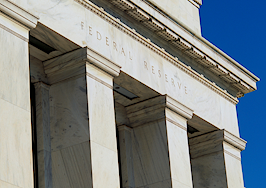The Federal Reserve could begin tapering its purchases of mortgage-backed securities as soon as November, adding momentum to market forces that have been pushing mortgage rates up in recent weeks.
The Fed has been careful to telegraph its intentions, in order to avoid surprising investors and sending rates soaring too quickly, as happened during the “taper tantrum” of 2013.
Minutes from the Federal Open Market Committee’s September meeting provide new details about the committee’s thinking, and how quickly it might withdraw its support for mortgages and government bonds.
At the outset of the coronavirus pandemic, the Fed started increasing its holdings mortgage-backed securities by $40 billion a month, and has also been adding $80 billion a month to its long-term Treasury holdings.
Those asset purchases helped bring mortgage rates to record lows, as increased demand for mortgage-backed securities meant investors — the ultimate source of funding for most home loans — would accept lower yields.
By making it cheaper to borrow, the Fed hoped to help prevent an economic crash during the pandemic. But with inflation now running hotter than some would like, most members of the Fed’s monetary policy committee think it will soon be time to scale those purchases back.
Minutes from the Fed’s September meeting show that if the economic recovery remains “broadly on track,” there’s general agreement among committee members that “a gradual tapering process that concluded around the middle of next year would likely be appropriate.”
Assuming committee members agree that it’s time to taper after their next meeting concludes on Nov. 3, “the process of tapering could commence with the monthly purchase calendars beginning in either mid-November or mid-December,” the minutes said.
At September’s meeting, committee members also came closer to agreeing on the mechanics of tapering. There’s been some speculation that the Fed might prioritize steeper reductions in either mortgage-backed securities or Treasurys.
An “illustrative path” proposed by Fed staff members would taper purchases proportionately over eight months, trimming purchases of mortgage-backed securities by $5 billion a month and Treasurys by $10 billion a month.
One scenario for Fed tapering

One scenario the Fed is considering for tapering its purchases of Treasurys and mortgage-backed securities. Source: Federal Open Market Committee meeting minutes.
If the Fed decided to start tapering in December, purchases aimed at increasing the Fed’s holdings of mortgage-backed securities and Treasurys would end in July, although the Fed would continue maintain its balance sheet by replacing maturing bonds.
Although no final decision has been made on when or how fast to taper, Fed staff members said the scenario discussed at September’s meeting was designed to be “simple to communicate,” and committee members generally agreed that it provided “a straightforward and appropriate template” that they might follow.
“Giving advance notice to the general public of a plan along these lines may reduce the risk of an adverse market reaction” to tapering, two committee members noted.
Speaking at an event in South Dakota this week, Fed board member Michelle Bowman expressed her support for gradual tapering concluding in mid-2022.

Michelle Bowman
“In my view, our asset purchases were an important part of our response to the economic effects of the pandemic, but they have essentially served their purpose,” Bowman said. “I am mindful that the remaining benefits to the economy from our asset purchases are now likely outweighed by the potential costs.”
Bowman, a Trump appointee, said she was particularly concerned that the Fed’s asset purchases “could now be contributing to valuation pressures, especially in housing and equity markets, or that maintaining a highly accommodative monetary policy stance at this stage of the economic expansion may pose risks to the stability of longer-term inflation expectations.”
If the economy keeps expanding as Bowman expects, “I will support a pace of tapering that would end our asset purchases by the middle of next year.”
But the minutes of the September meeting revealed that several committee members “preferred to proceed with a more rapid moderation of purchases.”

James Bullard
That would include St. Louis Federal Reserve President James Bullard, who told CNBC this week that he’d like to see tapering start in November, and be done the end of the first quarter of 2022.
Although Bullard has long been a proponent of “quantitative easing,” he says he now favors tapering quickly so the Fed can start raising short-term rates to fight inflation, if needed.
Federal Reserve Chairman Jerome Powell has said the Fed won’t start raising the short-term federal funds rate — which it cut to 0 percent at the outset of the pandemic — until it’s done tapering.
“I just want to be in a position in case we have to move sooner that we’re able to do so next year in the spring or summer if we have to do so,” Bullard told CNBC.
The CME FedWatch Tool, which monitors futures contracts to calculate the probability of Fed rate hikes, shows markets pricing in expectations for two 0.25 percentage point increases in the federal funds rate next year, with a 53 percent chance that the first increase will be approved in July 2022.
Mortgage rates, which are driven by market forces including investor appetite for mortgage-backed securities, have already been rising over worries about inflation and Fed tapering.
Mortgage rate forecast

Historic (through Q2 2021) and projected (Q3 2021 and beyond) rates for 30-year, fixed-rate mortgages. Source: Mortgage Bankers Association.
In a Sept. 21 forecast, economists at the Mortgage Bankers Association predicted rates on 30-year fixed-rate mortgage will increase by 20 basis points a quarter next year, averaging 4 percent during the final three months of 2022. MBA forecasters expect 30-year fixed-rate loans will average 4.3 percent in 2023.
Rising mortgage rates have already curbed demand for refinancing, and could cool home price increases — a development many homebuyers would welcome. But a sustained runup in mortgage rates could also dent home sales, some experts have warned.












